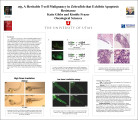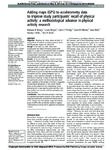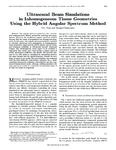Filters: Collection: "ir_uspace"
| Creator | Title | Description | Subject | Date | ||
|---|---|---|---|---|---|---|
| 151 |
 |
Jayamohan, Harikrishnan | Applications of microfluidics for molecular diagnostics | Diagnostic assays implemented in microfluidic devices have developed rapidly over the past decade and are expected to become commonplace in the next few years. Hundreds of microfluidics-based approaches towards clinical diagnostics and pathogen detection have been reported with a general theme of ra... | Microfluidics; Micro-total-analysis-systems; Lab-on-a-chip; Point-of-care devices; Sample preparation; MEMS; Rapid prototyping; Biomarker detection; Personalized medicine; Global health care | 2012-11-04 |
| 152 |
 |
Couldwell, William T. | Prognostic variables in surgery for skull base meningiomas | The authors have retrospectively analyzed selected surgical and pathological observations made among a group of 20 patients harboring recurrent cranial base meningiomas in an attempt to reveal which factors may be important in predicting tumor recurrence. This cohort was compared with a group of 3... | Skull base; Prognostic factor; Recurrence | 1997 |
| 153 |
 |
Capecchi, Mario R. | Expression of a microinjected porcine class I major histocompatibility complex gene in transgenic mice. | A porcine class I major histocompatibility complex (SLA) gene has been introduced into the genome of a C57BL/10 mouse. This transgenic mouse expressed SLA antigen on its cell surfaces and transmitted the gene to offspring, in which the gene is also expressed. Skin grafts of such transgenic mice were... | Genetic Engineering; Graft Rejection; Mice, Inbred C57BL | 1985-05-03 |
| 154 |
 |
Couldwell, William T.; Gillespie, David L.; Jensen, Randy L. | Comparison of the cell lines used in meningoma research | Background: Immortal cell lines and cell lines derived from operative specimens transplanted into animal models are used in meningioma research. We address two criticisms of the mouse xenograft flank tumor model: Why are tumor induction rates derived from operative specimens low and inconsistent? Ar... | CH-157 MN; IOMM-Lee; Meningioma; Xenograft Mouse Model; Flank tumors | 2008 |
| 155 |
 |
Gibbs, Katie Bernice; Frazer, John K. | otg, a heritable T-cell malignancy in zebrafish that exhibits apoptosis resistance | Otg (oscar the grouch), a line of zebrafish identified with a T cell malignancy pseudoposition, has a recessive inheritance pattern with approximately 50% penetrance in presumed homozygotes (m/m). After breeding otg with a wild-type lck::eGFP fish to create obligate heterozygotes (+/m), and then in... | otg; Oscar the grouch zebrafish; Apoptosis resistance; T cell malignancy; Pseudoposition; Trapeze Interactive poster | 2010-03-15 |
| 156 |
 |
Schmidt, Meic H. | Medical applications of space light-emitting diode technology-space station and beyond | Space light-emitting diode (LED) technology has provided medicine with a new tool capable of delivering light deep into tissues of the body, at wavelengths which are biologically optimal for cancer treatment and wound healing. This LED technology has already flown on Space Shuttle missions, and show... | Photodynamic therapy; Lutetium Texaphyrin; Lutex; Canine glioma | 1999 |
| 157 |
 |
Bernstein, Paul S.; Leppert, Mark F. | Genotype-phenotype analysis of ABCR variants in macular degeneration probands and siblings | PURPOSE: Single-copy variants of the autosomal recessive Stargardt disease (STGD1) gene ABCR (ABCA4) have been shown to confer enhanced susceptibility to age-related macular degeneration (AMD). To investigate the role of ABCR alleles in AMD further, genotype-phenotype analysis was performed on sibli... | DNA Mutational Analysis; Nuclear Family; Phenotype | 2002 |
| 158 |
 |
Schmidt, Meic H.; Brockmeyer, Douglas Lee; Dailey, Andrew T. | Surgical management of aneurysmal bone cysts of the spine | Object. Aneurysmal bone cysts of the spine are benign, highly vascular osseous lesions of unknown origin that may present difficult diagnostic and therapeutic challenges. They are expansile lesions containing thin-walled, blood-filled cystic cavities that cause bone destruction and sometimes spinal ... | Aneurysmal bone cyst; Spine tumor; Spinal fusion; Embolization | 2003 |
| 159 |
 |
Brown, Barbara B. | Adding maps (GPS) to accelerometry data to improve study participants recall of physical activity: a methodological advance in physical activity research | Objective Obtaining the ‘when, where and why' of healthy bouts of moderate-to-vigorous physical activity (MVPA) provides insights into natural PA. Design In Salt Lake City, Utah, adults wore accelerometer and Global Positioning System (GPS) loggers for a week in a cross-sectional study to establis... | 2014-01-01 | |
| 160 |
 |
Spencer S. Eccles Health Sciences Library, University of Utah | IAIMS Newsletter Spring 2003 | The IAIMS Newsletter is published three times a year (August, January, May) with one InfoFair supplement and provides valuable information about Library activities and resources as well as informative articles related to information technology. | IAIMS | 2003-02-21 |
| 161 |
 |
Kestle, John R. W. | Potentially useful outcome measures for clinical research in pediatric neurosurgery | The choice of outcome (or outcomes) and their measurement are critical for a sound clinical trial. Surgeons have traditionally measured simple outcomes such as death, duration of survival, or tumor recurrence but have recently developed more sophisticated measures of the effect of an intervention. M... | Pediatric neurosurgery | 2005 |
| 162 |
 |
Schliep, Karen | Critical analysis of information: an epidemiologic perspective | A slideshow presentation discussing methods for critically evaluating medical literature and observational studies | Life sciences literature--Evalutation | 2017-04-21 |
| 163 |
 |
Anderson, Richard Bryan | IMHBCO (In my humble but correct opinion): the journal issue and the record album: two fundamentally irrational information products | Over the past few years I've become more and more convinced that the scholarly information world has a lot to learn from the music industry. Not so much from what the latter is doing either right or wrong, but from what has happened to it over the past 100 years, how it has happened, and why. From ... | 2009 | |
| 164 |
 |
Gardner, Reed M. | Prospective Comparison of Arterial Catheter Blood and Catheter-Tip Cultures in Critically Ill Patients | Biomedical Informatics | 1984 | |
| 165 |
 |
Couldwell, William T.; Schmidt, Richard H.; Salzman, Karen L.; Chin, Steven S. | Glioblastoma multiforme of the pineal region | Glioblastoma multiforme (GBMs) tumors are exceedingly rare tumors in the pineal region. We present three cases in which patients presented with a pineal/posterior third ventricular region mass and review all the previously reported cases in the literature. Pineal region GBM seems to be a very aggre... | Glioblastoma multiforme; Hydrocephalus; Leptomeningeal dissemination; Malignant glioma; Perinaud's syndrome; Pineal region; Spinal metastases | 2006 |
| 166 |
 |
O'Rourke, Dennis H. | Ascertainment bias for non-twin relatives in twin proband studies | When families are ascertained through affected twins, as for example when twin probands are selected from a registry and their non-twin relatives studied, a correction for ascertainment bias is needed. It is shown that probandwise counting (where relatives of doubly ascertained twin pairs are counte... | Genetic; Transmission; Models | 1982 |
| 167 |
 |
Gesteland, Raymond F.; Krapcho, Karen J.; Talbot, Phil; Thulin, Craig | Crystallization of the MS2 translational repressor alone and complexed to bromouridine | The coat protein from the MS2 bacteriophage plays a dual role by encapsidating viral RNA and also by binding RNA as a translational repressor. In order to study the isolated dimer in a conformation not influenced by capsid interactions, a mutant molecule was crystallized that is defective in capsid ... | Crystallization; RNA Bacteriophage; RNA Hairpin; Translational Repressor | 1995 |
| 168 |
 |
Kriesel, John D.; Gooch, Willis M.; Pavia, Andrew T. | Invasive sinonasal disease due to Scopulariopsis candida: case report and review of scopulariopsosis. | Sinonasal infection with fungi of the order Mucorales--termed mucormycosis or zygomycosis--is sometimes seen in immunosuppressed patients, including those with diabetic ketoacidosis and malignancy. We describe a case of invasive sinonasal infection with Scopulariopsis candida (not among the Mucorale... | Granulocyte Colony-Stimulating Factor; Itraconazole; Maxillary Sinus | 1994 |
| 169 |
 |
Battin, Margaret P. | On the relationship between suicide-prevention and suicide-advocacy groups | Largely in response to contemporary medicine's advancing technological capacities to extend the process of dying to extraordinary lengths, recent years have seen the emergence of numerous advocacy groups concerned with what is often called "death with dignity." For instance, the New York-based group... | Suicide prevention; Suicide advocacy; Death with dignity; Suicidology | 1982 |
| 170 |
 |
Coley, Phyllis D. | On turning green into gold | Anthropogenic effects on the climate and biodiversity of our planet are among the most troubling and perhaps irreversible threats facing scientists, policymakers, and citizens. Yet many scientists are reluctant or unsure of how to apply their expertise in basic science to these pressing real-world p... | Bioprospecting; Drug discovery; Active compounds; Panama | 2008 |
| 171 |
 |
Couldwell, William T. | Protein kinase C and growth regulation in malignant gliomas | To the Editor: The presence of amplified growth factor systems in many tumor models, including malignant gliomas, raises the question of how such external signals are transduced into a transformed phenotype (increased proliferation, invasion, lack of contact inhibition, angiogenic capacity, etc.). ... | Protein kinase C; Glioma; Brain neoplasm; protooncogenes; Apoptosis; Tamoxifen | 1994 |
| 172 |
 |
Battin, Margaret P. | Legal physician-assisted dying in Oregon and the Netherlands: evidence concerning the impact on patients in "vulnerable" groups | If physician-assisted suicide (PAS) and/or voluntary active euthanasia were legalised, would this disproportionately affect people in ‘‘vulnerable'' groups? Although principles of patient autonomy and the right to avoid suffering and pain may offer support for these practices, concerns about the... | Vulnerable groups; Oregon; Netherlands | 2007-10-01 |
| 173 |
 |
Brown, Barbara B. | Physical activity mediates the relationship between perceived crime safety and obesity | Objective. The current cross-sectional study tests whether low perceived crime safety is associated with body mass index (BMI) and obesity risk and whether less moderate-to-vigorous physical activity (MVPA) accounts for part of this relationship. Method. Adults (n=864) from a relatively low-income a... | 2014-01-01 | |
| 174 |
 |
Christensen, Douglas A. | Ultrasound beam simulations in inhomogeneous tissue geometries using the hybrid angular spectrum method | The angular spectrum method is a fast, accurate and computationally efficient method for modeling wave propagation. However, the traditional angular spectrum method assumes that the region of propagation has homogenous properties. In this paper, the angular spectrum method is extended to calculate u... | 2012-01-01 | |
| 175 |
 |
Schmidt, Meic H. | Diffuse large B-cell lymphoma presenting as a sacral tumor | Primary lymphomas of the sacrum are rare tumors, reported only in a few cases in the literature. The authors describe two patients with diffuse large B-cell lymphomas presenting as a sacral tumor. In the first case a 52-year-old man presented with progressive back pain, bilateral radicular pain, an... | B-cell lymphoma; Sacral tumor | 2003 |
